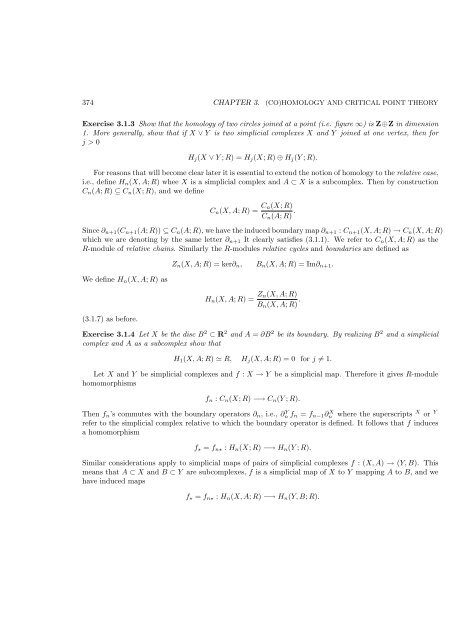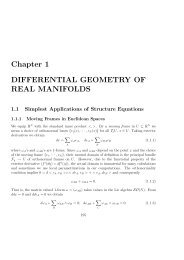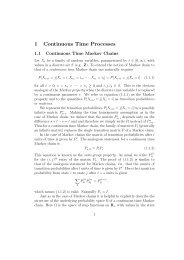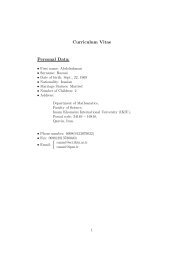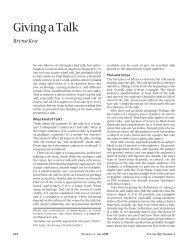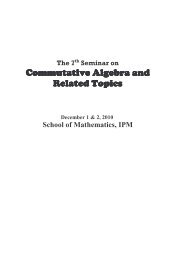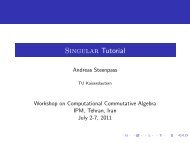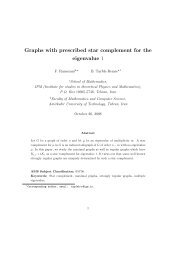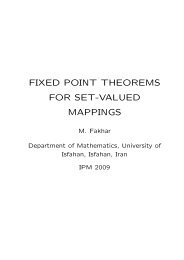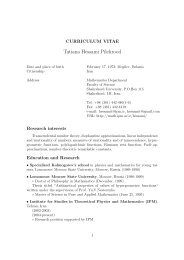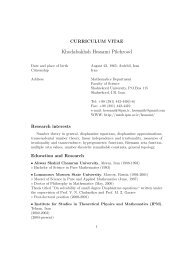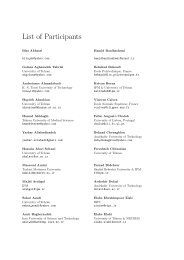(CO)HOMOLOGY AND CRITICAL POINT THEORY - Math - IPM
(CO)HOMOLOGY AND CRITICAL POINT THEORY - Math - IPM
(CO)HOMOLOGY AND CRITICAL POINT THEORY - Math - IPM
You also want an ePaper? Increase the reach of your titles
YUMPU automatically turns print PDFs into web optimized ePapers that Google loves.
374 CHAPTER 3. (<strong>CO</strong>)<strong>HOMOLOGY</strong> <strong>AND</strong> <strong>CRITICAL</strong> <strong>POINT</strong> <strong>THEORY</strong><br />
Exercise 3.1.3 Show that the homology of two circles joined at a point (i.e. figure ∞) is Z⊕Z in dimension<br />
1. More generally, show that if X ∨ Y is two simplicial complexes X and Y joined at one vertex, then for<br />
j > 0<br />
Hj(X ∨ Y ; R) = Hj(X; R) ⊕ Hj(Y ; R).<br />
For reasons that will become clear later it is essential to extend the notion of homology to the relative case,<br />
i.e., define Hn(X, A; R) whee X is a simplicial complex and A ⊂ X is a subcomplex. Then by construction<br />
Cn(A; R) ⊆ Cn(X; R), and we define<br />
Cn(X, A; R) = Cn(X; R)<br />
Cn(A; R) .<br />
Since ∂n+1(Cn+1(A; R)) ⊆ Cn(A; R), we have the induced boundary map ∂n+1 : Cn+1(X, A; R) → Cn(X, A; R)<br />
which we are denoting by the same letter ∂n+1 It clearly satisfies (3.1.1). We refer to Cn(X, A; R) as the<br />
R-module of relative chains. Similarly the R-modules relative cycles and boundaries are defined as<br />
We define Hn(X, A; R) as<br />
(3.1.7) as before.<br />
Zn(X, A; R) = ker∂n, Bn(X, A; R) = Im∂n+1.<br />
Hn(X, A; R) = Zn(X, A; R)<br />
Bn(X, A; R) .<br />
Exercise 3.1.4 Let X be the disc B 2 ⊂ R 2 and A = ∂B 2 be its boundary. By realizing B 2 and a simplicial<br />
complex and A as a subcomplex show that<br />
H1(X, A; R) R, Hj(X, A; R) = 0 for j = 1.<br />
Let X and Y be simplicial complexes and f : X → Y be a simplicial map. Therefore it gives R-module<br />
homomorphisms<br />
fn : Cn(X; R) −→ Cn(Y ; R).<br />
Then fn’s commutes with the boundary operators ∂n, i.e., ∂ Y n fn = fn−1∂ X n where the superscripts X or Y<br />
refer to the simplicial complex relative to which the boundary operator is defined. It follows that f induces<br />
a homomorphism<br />
f⋆ = fn⋆ : Hn(X; R) −→ Hn(Y ; R).<br />
Similar considerations apply to simplicial maps of pairs of simplicial complexes f : (X, A) → (Y, B). This<br />
means that A ⊂ X and B ⊂ Y are subcomplexes, f is a simplicial map of X to Y mapping A to B, and we<br />
have induced maps<br />
f⋆ = fn⋆ : Hn(X, A; R) −→ Hn(Y, B; R).


